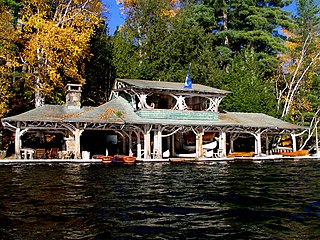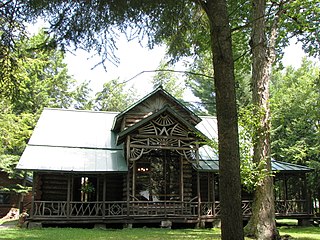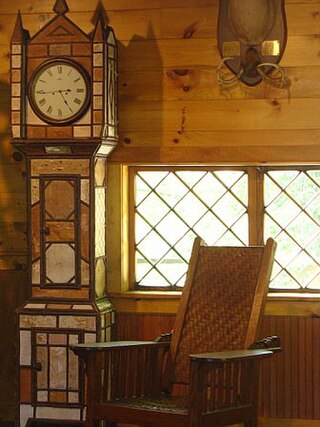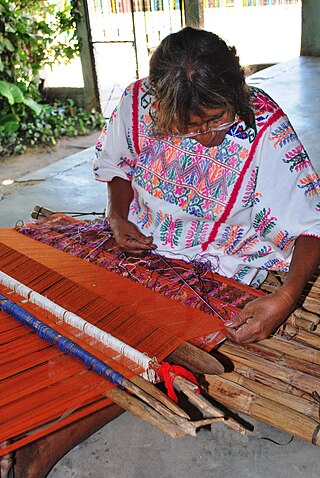
Furniture refers to objects intended to support various human activities such as seating, eating (tables), storing items, working, and sleeping. Furniture is also used to hold objects at a convenient height for work, or to store things. Furniture can be a product of design and can be considered a form of decorative art. In addition to furniture's functional role, it can serve a symbolic or religious purpose. It can be made from a vast multitude of materials, including metal, plastic, and wood. Furniture can be made using a variety of woodworking joints which often reflects the local culture.

An antique is an item perceived as having value because of its aesthetic or historical significance, and often defined as at least 100 years old, although the term is often used loosely to describe any object that is old. An antique is usually an item that is collected or desirable because of its age, beauty, rarity, condition, utility, personal emotional connection, and/or other unique features. It is an object that represents a previous era or time period in human history. Vintage and collectible are used to describe items that are old, but do not meet the 100-year criterion.

A writing table has a series of drawers directly under the surface of the table, to contain writing implements, so that it may serve as a desk. Antique versions have the usual divisions for the inkwell, the blotter and the sand or powder tray in one of the drawers, and a surface covered with leather or some other material less hostile to the quill or the fountain pen than simple hard wood.

A couch, also known as a sofa, settee, chesterfield, or davenport, is a cushioned item of furniture that can seat multiple people. It is commonly found in the form of a bench with upholstered armrests and is often fitted with springs and tailored cushion and pillows. Although a couch is used primarily for seating, it may be used for sleeping. In homes, couches are normally put in the family room, living room, den, or lounge. They are sometimes also found in non-residential settings such as hotels, lobbies of commercial offices, waiting rooms, and bars. Couches can also vary in size, color, and design.

A piece of antique furniture is a collectible interior furnishing of considerable age. Often the age, rarity, condition, utility, or other unique features make a piece of furniture desirable as a collectors' item, and thus termed an antique. The antique furniture pieces reflect the style and features of the time they were made; this can be called the antique's "period". Christie's defines it as being over 100 years old.

A lowboy is an American collectors term for one type of dressing table. It is a small table with one or two rows of drawers, so called in contradistinction to the tallboy or highboy chest of drawers.

Betye Irene Saar is an American artist known for her work in the medium of assemblage. Saar is a visual storyteller and an accomplished printmaker. Saar was a part of the Black Arts Movement in the 1970s, which engaged myths and stereotypes about race and femininity. Her work is considered highly political, as she challenged negative ideas about African Americans throughout her career; Saar is best known for her artwork that critiques anti-Black racism in the United States.

Distressing in the decorative arts is the activity of making a piece of furniture or object appear aged and older, giving it a "weathered look". There are many methods to produce an appearance of age and wear. Distressing is viewed as a refinishing technique although it is the opposite of finishing in a traditional sense. In distressing, the object's finish is intentionally destroyed or manipulated to look less than perfect, such as with sandpaper or paint stripper. For example, the artisan often removes some but not all of the paint, leaving proof of several layers of paint speckled over wood grain underneath. This becomes the "finished" piece.

National Park Service rustic – sometimes colloquially called Parkitecture – is a style of architecture that developed in the early and middle 20th century in the United States National Park Service (NPS) through its efforts to create buildings that harmonized with the natural environment. Since its founding in 1916, the NPS sought to design and build visitor facilities without visually interrupting the natural or historic surroundings. The early results were characterized by intensive use of hand labor and a rejection of the regularity and symmetry of the industrial world, reflecting connections with the Arts and Crafts movement and American Picturesque architecture.

The Great Camps of the Adirondack Mountains refers to the grandiose family compounds of cabins that were built in the latter half of the nineteenth century on lakes in the Adirondacks such as Spitfire Lake and Rainbow Lake. The camps were summer homes for the wealthy, where they could relax, host or attend parties, and enjoy the wilderness. In time, however, this was accomplished without leaving the comforts of civilization behind; some great camps even contained a bowling alley or movie theatre.

Adirondack Architecture refers to the rugged architectural style generally associated with the Great Camps within the Adirondack Mountains area in New York. The builders of these camps used native building materials and sited their buildings within an irregular wooded landscape. These camps for the wealthy were built to provide a primitive, rustic appearance while avoiding the problems of in-shipping materials from elsewhere.

The forms of Chinese furniture evolved along three distinct lineages which date back to 1000 BC: frame and panel, yoke and rack and bamboo construction techniques. Chinese home furniture evolved independently of Western furniture into many similar forms, including chairs, tables, stools, cupboards, cabinets, beds and sofas. Until about the 10th century CE, the Chinese sat on mats or low platforms using low tables, but then gradually moved to using high tables with chairs.

Camp Pine Knot, also known as Huntington Memorial Camp, on Raquette Lake in the Adirondack Mountains of New York State, was built by William West Durant. Begun in 1877, it was the first of the "Adirondack Great Camps" and epitomizes the "Great Camp" architectural style. Elements of that style include log and native stonework construction, decorative rustic items of branches and twigs, and layout as a compound of separated structures. It is located on the southwest tip of Long Point, a two-mile long point extending into Raquette Lake, in the Town of Long Lake in Hamilton County, New York.

Adirondack Experience, located on NY-30 in the hamlet of Blue Mountain Lake in Hamilton County, New York, is a museum dedicated to preserving the history of the Adirondacks. The museum is located on the site of an historic summer resort hotel, the Blue Mountain House, built high above Blue Mountain Lake in 1876 by Miles Tyler Merwin, that operated until the late 1940s. The museum consists of 23 buildings, 121 acres, and 60,000 square feet of exhibition space. The opening of a brand new 19,000 square foot exhibition, Life in the Adirondacks, took place July 2017.

Twig-work is the term applied to architectural details constructed of twigs and branches to form decorative motifs in buildings and furniture. Carpentry or woodworking using wood that has not been milled into lumber and is still in its natural shape describes the national park service rustic style.

Joseph O.A. Bryere, was a guide in the Adirondacks and a noted woodworking artist whose style played a significant role in creating the rustic, “Adirondack look” we know today. Along with Ernest Stowe, Seth Pierce, George Wilson and other master craftsmen, Bryere helped create the rustic aura so desired in the Adirondack great camps of the late 19th century and early 20th century.

The handcrafts of Guerrero include a number of products which are mostly made by the indigenous communities of the Mexican state of Guerrero. Some, like pottery and basketry, have existed relatively intact since the pre Hispanic period, while others have gone through significant changes in technique and design since the colonial period. Today, much of the production is for sale in the state's major tourism centers, Acapulco, Zihuatanejo and Taxco, which has influence the crafts’ modern evolution. The most important craft traditions include amate bark painting, the lacquerware of Olinalá and nearby communities and the silverwork of Taxdo.

A cabinet is a case or cupboard with shelves or drawers for storing or displaying items. Some cabinets are stand alone while others are built in to a wall or are attached to it like a medicine cabinet. Cabinets are typically made of wood, coated steel, or synthetic materials. Commercial grade cabinets usually have a melamine-particleboard substrate and are covered in a high-pressure decorative laminate, commonly referred to as Wilsonart or Formica.

Mexican lacquerware is one of the country's oldest crafts, having independent origins from Asian lacquerware. In the pre-colonial period, a greasy substance from the aje larvae and/or oil from the chia seed were mixed with powdered minerals to create protective coatings and decorative designs. During this period, the process was almost always applied to dried gourds, especially to make the cups that Mesoamerican nobility drank chocolate from. After the Conquest, the Spanish had indigenous craftsmen apply the technique to European style furniture and other items, changing the decorative motifs and color schemes, but the process and materials remained mostly the same. In the 19th and 20th centuries, the craft waned during armed conflicts and returned, both times with changes to the decorative styles and especially in the 20th century, to production techniques. Today, workshops creating these works are limited to Olinalá, Temalacatzingo and Acapetlahuaya in the state of Guerrero, Uruapan and Pátzcuaro in Michoacán and Chiapa de Corzo in Chiapas.
Furniture repair is the craft of making broken or worn furniture usable again. It may include the preservation of old furniture, which is referred to as restoration. The craft of furniture repair requires a number of different skills including woodworking, metalworking, wood finishing, caning (furniture), woodturning, and upholstery.




















